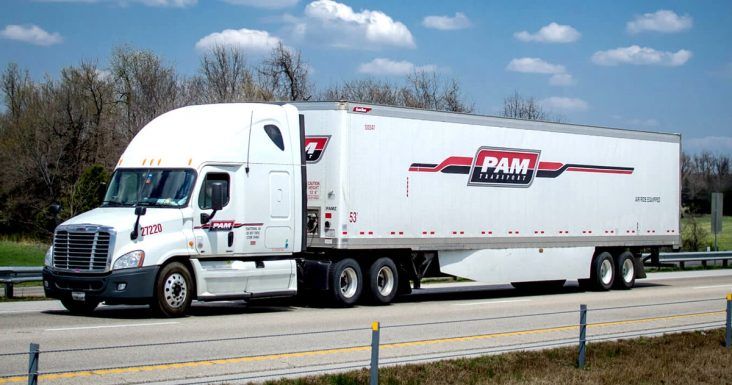P.A.M. earnings rise 19%, revenue falls 2% in second quarter
by July 15, 2019 7:23 pm 636 views

P.A.M. Transportation Services’ profit increased 18.7%, and revenue declined 1.7% in the second quarter as freight demand was softer than 2018 levels and customers put downward pressure on rates.
After the markets closed Monday (July 15), the Tontitown-based carrier reported second-quarter earnings were $8.65 million, or $1.45 per share, up from $7.29 million, or $1.17 per share, in the same period in 2018. Revenue was $133 million, down from $135.3 million.
In the first six months of the year, earnings rose 95.4% to $16.96 million, or $2.84 per share, from $8.68 million, or $1.39 per share. Revenue increased 2.7% to $261.69 million, from $254.76 million.
“We are very pleased with our financial performance for the second quarter 2019, which resulted in our best second-quarter operating income on record and the second best quarterly operating income in the company’s history,” President Daniel Cushman said. “Eleven of our last 13 months have each set records for operating income for their respective month, and the two months that did not set a record were the second best for their respective month.”
The growth in operating income was a result of increasing the company’s fleet size and improving its operating margin, Cushman said. The company was able to increase the size of its fleet as a result of customer rate increases, and this led the company to increase driver and contractor pay, which allowed the company to better recruit drivers while also decreasing turnover. Excluding driver pay, margin improvement also was offset by rising costs for replacement equipment, recruiting and insurance costs.
In the second quarter, the carrier had 1,520 company trucks, up from 1,324 in the same period in 2018. Average contractor trucks were 545, down from 550 in the same period in 2018. Revenue per mile was $1.71, up from $1.56, and revenue per truck per day was $703, down from $743.
The company has been challenged to retain existing customer rates to cover the increased driver pay rates and other costs, Cushman said. The company has yet to reduce rates on existing lanes, but the company hasn’t been able to add new business at similar margins like in 2018, he said. Some have said 2019 has been a bad year for freight demand but not so for P.A.M. It has not been as strong as in 2018, but demand has been better than 2016 and 2017 levels, Cushman said. Driver recruitment continues to be a challenge, and the rate increases so far have yet to resolve the driver shortage, Cushman said. He also doesn’t expect any significant price decreases in operating costs in the short term. However, if demand improves, the downward pressure on rates should decline.
The company’s Mexico division continues to grow in asset and non-asset services. Northbound demand exceeds the company’s capacity, and it is investing in alternate services, including brokerage.
Demand for dedicated services has been similar to 2018 levels, and growth in the business has come from an automotive customer, with which the carrier has reached a three-year agreement.
With regard to logistics operations, revenue fell 18% to $19.49 million. In the past six months, revenue decreased by 5.9% to $39.82 million. Operating ratio, which is operating expenses as a percentage of revenue, was 93.87% in the second quarter and improved from 94.39% in the same period in 2018. The decline in spot market rates negatively impacted revenue for the second quarter, Cushman said, adding that margins are improved from 2018.
Shares of P.A.M. (NASDAQ: PTSI) closed Monday at $58, down 31 cents, or 0.53%. In the past 52 weeks, the stock has ranged between $70 and $34.31.
